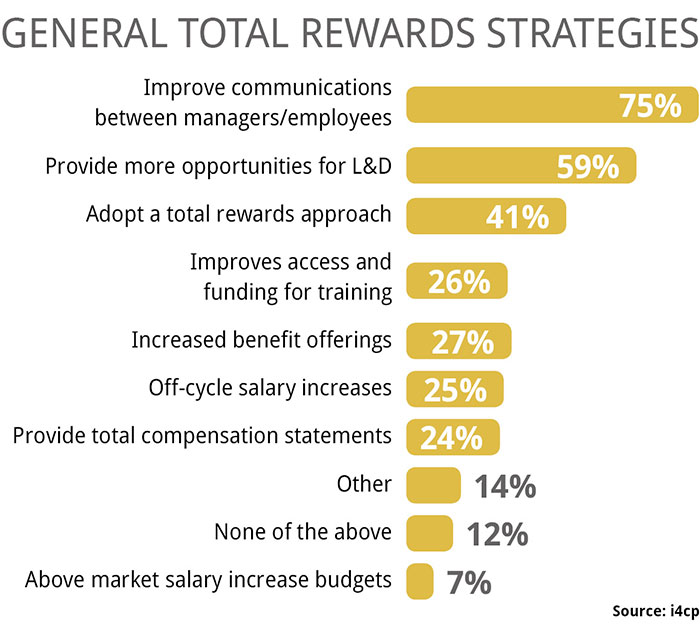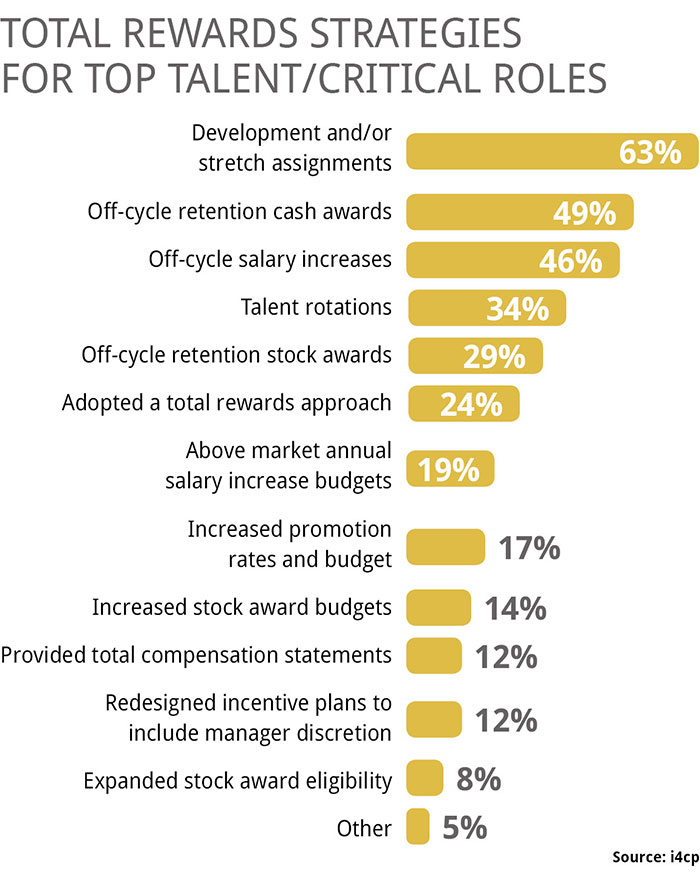Six Total Rewards Strategies for Stormy Times

When the Institute for Corporate Productivity’s (i4cp) Total Rewards Leader Board commissioned a pulse survey on how to respond to challenging market conditions, seven of ten total rewards (TR) Leaders reported that their organizations had experienced elements of performance volatility and disruption in the preceding three years. And most reported that they are responding to such volatility with more focus on manager employee communications and learning and development for their general workforce; nearly two-thirds cited use of development and stretch assignments for top-performers and critical roles.
"Every organization will go through tough times. The total rewards leader needs to be ready with alternatives that can be applied to the general workforce, and top talent specifically,” explains Mark Englizian, Chair of i4cp’s Total Rewards Leader Board, and former CHRO for Walgreens and Global Leader for Total Rewards with Amazon.
Survey responses from total rewards leaders identified several specific disruptive factors making it more difficult to attract and retain talent. For example:
- 45% reported bonus payouts below targets for one or more years
- 37% reported job losses due to market pressure and M&A activity
- 28% reported CEO turnover and/or attrition of two or more executives reporting to the CEO
- 23% reported a loss in market value of more than 10%
- 15% reported a change in control
- 15% reported negative media attention
And nearly all of these disruptions had direct impact on organizational reputation, survey respondents indicated.
How are total rewards leaders responding to disruption, market decline, and otherwise “stormy” weather? The survey indicated six core responses to address such disruption and uncertainty in anticipation of sunnier days ahead:
1. Make it a priority to consistently nurture and develop top talent.
While it may be tempting to cut costs for development and training, these programs may be among the most effective strategies required for any transition or turnaround. Our survey found that 59% of companies said they provided more (not fewer) opportunities for learning and development during times of disruption or market decline. More than a third (36%) said they had improved access and funding for training programs.
"Not surprisingly, the most common and effective reward strategies include development and talent rotations—low cost, high return," Englizian explains. High-performers looking for challenges may see opportunities for promotion and professional growth not available with more traditionally “successful” companies.
2. Improve communications between managers and employees.
While it may seem basic, nearly 75% of survey respondents said they had worked to improve communications between managers and employees during times of disruption and volatility. This strategy was not only the most common total reward strategy employed, it was also the most effective in improving an organization’s attractiveness, according to respondents.
Total rewards leaders note that it can take two-to-three (or more) years to turn around a company. During such times, “ . . . equity participation doesn’t get the bang for the buck,” explained one total rewards leader. What does? Core levels of trust established via frequent discussions about what needs to get done and how.
In support of this finding, i4cp research on performance management also indicates a top focus of high-performance organizations on developing effective feedback practices and enabling quality performance conversations. Talent development is a key outcome of these practices.
3. Provide opportunities for learning and development
The second-most deployed strategy for the general workforce—providing opportunities for learning and development—was reported by respondents to be the second-most effective in improving an organization’s attractiveness. This aligns with prior i4cp’s research calling for managers to be accountable for developing their talent and creating a culture of learning.
Total rewards leaders also said that increasing access and funding for learning and development is an effective strategy to increase hiring and retention attractiveness.
This is also in line with other i4cp research into the practices of high-performance organizations that supports talent mobility and experiential learning.

4. Broaden the use of total rewards strategies—especially non-cash rewards.
Nearly 41% of respondents said their organizations had adopted a total rewards approach during times of disruption. Perhaps tellingly, total rewards leaders indicated this is not a broad-brush approach, rather, total rewards practices need to be tailored to individual preferences and needs. “This is something that needs to be done with specific, customized messaging,” commented one total rewards leader—noting that the roll-out of a total rewards communication plan can include literally hundreds of tailored total rewards statements and segments.
While cash comp is often seen as a “hygiene factor,” a basic requirement for fairness and equity, few experienced reward leaders use it to motivate and ensure sustained performance. More often, once cash is paid, the employee can be gone tomorrow if not combined with other strategies, total rewards leaders said.
5. Differentiate more (not less) in your total rewards strategies.
Tough times mean more differentiation in pay and other rewards programs rather than less, total rewards leaders noted. A common refrain among survey respondents was: “We need to be much more deliberate about how we spend our money.” And many reported changing the slope of their payouts, with top-performers receiving 10%.
Differentiation is not all about pay. It can also be about opportunities and attention. “I invested in someone who could’ve left, but now they are in a senor role that they might never have achieved under more ‘normal’ business conditions,” one leader explained.
6. Use of combination and personalized total rewards strategies.
When it comes to retaining top talent and those in critical roles, organizations implement several top strategies. Nearly 63% said they had implemented development and/or stretch assignments and 34% said they had used talent rotations.
Pay played a more critical role in addressing top talent and critical roles, with 49% using off-cycle retention cash awards and 46% using off-salary increases. All four of these areas were noted as effective by survey participants suggesting the integrated approach to pay and non-pay rewards required for managing critical and top talent.

Other strategies mentioned by survey participants included redesigned incentive plans, flexible working arrangements, flexible PTO, talent investment pools, and aggressive rotation of talent.
The i4cp Total Rewards Leader Board explores next practices in total rewards through research, shared strategies and tools, and peer discussion. For more information on becoming part of this leading edge working group, contact Board chair Mark Englizian at mark.englizian@i4cp.com.




